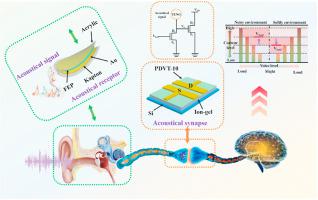Nano Energy ( IF 17.6 ) Pub Date : 2020-09-19 , DOI: 10.1016/j.nanoen.2020.105403 Yaqian Liu , Enlong Li , Xiumei Wang , Qizhen Chen , Yilun Zhou , Yuanyuan Hu , Gengxu Chen , Huipeng Chen , Tailiang Guo

|
Human auditory system is one of the most efficient and important biological system for human beings. To reproduce this system with electronic devices would profoundly advance artificial nervous system. However, emulating this system requires a complex architecture to mimic the biological auditory system functions such as listening, analyzing, and integrating instructions, which is still not available. Here, we report a triboelectric nanogenerator (TENG) actuated self-powered artificial auditory pathway to emulate the biological auditory functionalities, demonstrating its application in the intelligent neuromorphic computing and sound detection. The self-powered artificial auditory pathway consists of a femtosecond laser (fs) processed TENG and a field effect synaptic transistor (FEST) which functions as acoustic receptor and acoustic synapse, respectively. Moreover, the fs laser-induced auditory TENG exhibits broader frequency response with high sensitivity (129 mV/dB), and excellent empathy social behavior, and various typical synaptic functions can be well mimicked through TENG actuated FEST. Meanwhile, a self-adaptation artificial neuromorphic circuit with noise-adjustable behavior is demonstrated, which substantially improves the efficiency and accuracy of the instruction recognition process for more human-computer interaction system. This work provides an effective way to well mimic the biological auditory functions, which paves a new way to achieve the instruction recognition in a noise-intensity range ambient, and would profoundly decrease the power-consumption in the field of future neuromorphic systems.
中文翻译:

自供电的人工听觉通路,用于智能神经形态计算和声音检测
人体听觉系统是人类最有效,最重要的生物系统之一。用电子设备重现该系统将极大地促进人工神经系统。但是,模拟此系统需要复杂的体系结构来模仿生物听觉系统的功能,例如聆听,分析和集成指令,目前尚不可用。在这里,我们报告一个摩擦电纳米发电机(TENG)驱动的自供电人工听觉途径来模拟生物听觉功能,表明其在智能神经形态计算和声音检测中的应用。自供电的人工听觉通路由飞秒激光(fs)处理的TENG和场效应突触晶体管(FEST)组成,该晶体管用作听觉感受器和听觉突触,分别。此外,fs激光诱导的听觉TENG表现出更宽的频率响应,具有高灵敏度(129 mV / dB)和出色的共情社交行为,并且通过TENG激活的FEST可以很好地模仿各种典型的突触功能。同时,演示了一种具有噪声可调节行为的自适应人工神经形态电路,它为更多的人机交互系统大大提高了指令识别过程的效率和准确性。这项工作提供了一种有效地模仿生物听觉功能的有效方法,这为在噪声强度范围内的环境中实现指令识别铺平了一条新途径,并将大大降低未来神经形态系统领域的功耗。fs激光诱导的TENG表现出更宽的频率响应,具有高灵敏度(129 mV / dB)和出色的共情社交行为,并且通过TENG激活的FEST可以很好地模仿各种典型的突触功能。同时,演示了一种具有噪声可调节行为的自适应人工神经形态电路,它为更多的人机交互系统大大提高了指令识别过程的效率和准确性。这项工作提供了一种有效地模仿生物听觉功能的有效方法,这为在噪声强度范围内的环境中实现指令识别铺平了一条新途径,并将大大降低未来神经形态系统领域的功耗。fs激光诱发的听觉TENG表现出更宽的频率响应,具有高灵敏度(129 mV / dB)和出色的共情社交行为,并且通过TENG激活的FEST可以很好地模仿各种典型的突触功能。同时,演示了一种具有噪声可调节行为的自适应人工神经形态电路,它为更多的人机交互系统大大提高了指令识别过程的效率和准确性。这项工作提供了一种有效地模仿生物听觉功能的有效方法,这为在噪声强度范围内的环境中实现指令识别铺平了一条新途径,并将大大降低未来神经形态系统领域的功耗。通过TENG启动的FEST,可以很好地模仿各种典型的突触功能。同时,演示了一种具有噪声可调节行为的自适应人工神经形态电路,它为更多的人机交互系统大大提高了指令识别过程的效率和准确性。这项工作提供了一种有效地模仿生物听觉功能的有效方法,这为在噪声强度范围内的环境中实现指令识别铺平了一条新途径,并将大大降低未来神经形态系统领域的功耗。通过TENG启动的FEST,可以很好地模仿各种典型的突触功能。同时,演示了一种具有噪声可调节行为的自适应人工神经形态电路,它为更多的人机交互系统大大提高了指令识别过程的效率和准确性。这项工作提供了一种有效地模仿生物听觉功能的有效方法,这为在噪声强度范围内的环境中实现指令识别铺平了一条新途径,并将大大降低未来神经形态系统领域的功耗。这大大提高了更多人机交互系统的指令识别过程的效率和准确性。这项工作提供了一种有效地模仿生物听觉功能的有效方法,这为在噪声强度范围内的环境中实现指令识别铺平了一条新途径,并将大大降低未来神经形态系统领域的功耗。从而大大提高了更多人机交互系统的指令识别过程的效率和准确性。这项工作提供了一种有效地模仿生物听觉功能的有效方法,这为在噪声强度范围内的环境中实现指令识别铺平了一条新途径,并将大大降低未来神经形态系统领域的功耗。


























 京公网安备 11010802027423号
京公网安备 11010802027423号